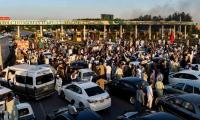Educational institutions for special students ignored again
LAHORE
The latest education statistics issued by the federal government’s educational planning and management body, which placed Punjab on the top vis-à-vis provision of basic facilities in public schools across Pakistan, has once again ignored data about special education institutions for children with disabilities.
The Academy of Educational Planning and Management (AEPAM) report provides data about technical education and vocational training institutes, non-formal education, deeni madaris (religious seminaries) and even teacher training institutions but what is badly missing in the report is data about special education centres, students and teachers and related infrastructural provisions.
A disability rights activist Nadir Khan, who is a wheelchair user, sees this as discrimination and says data is really important to initiate an informed debate. He said the provincial bodies didn’t make data public; therefore, the AEPAM’s report was really important for all the stakeholders.
It is pertinent to mention here that the federal government was not counting persons with disabilities (PWDs) in the ongoing census. However, now on the directions of the Supreme Court disabled persons are being counted.
“This is unfortunate that the AEPAM report is blank on special education institutions, students and teachers as well as missing facilities in such institutions across the country,” Nadir said and demanded the government to ensure that special education also gets due attention in the next volumes of the report.
Meanwhile, according to the report, Punjab tops the list of all the four provinces and federating units as well as Islamabad Capital Territory (ICT) in terms of provision of basic facilities, including drinking water, electricity, toilets and boundary walls in public schools.
As per analysis of the AEPAM statistics, less than one percent public schools in Punjab don’t have water facility while in Sindh, almost 50 percent schools don’t have this basic facility. In Balochistan, 43 percent and in Khyber-Pakhtunkhwa (KP), 26 percent schools don’t have water facilities for students and teachers.
Similarly in terms of availability of toilets, as per the report, Punjab is far ahead than other provinces with just one percent schools lacking this facility. Balochistan has 73 percent, Sindh 46 percent and KP 12 percent such schools.
The schools without boundary walls have gained more attention in the wake of prevailing law and order and Punjab, the report claims, have only 2 percent schools without boundary walls while Balochistan has 55 percent, Sindh 41 percent and KP 13 percent.
The non-availability of electricity in government schools in Punjab is, however, higher than above-mentioned facilities as 7 percent schools don’t have electricity in the province. Balochistan has 77 percent such schools, Sindh 63 percent and KP 38 percent. The overall stats show poor condition of schools in Balochistan and Sindh, followed by KP and Punjab.
The schoolteachers in Punjab, however, don’t like the way the situation vis-à-vis availability of basic facilities has been ‘glorified’. Hafiz Ghulam Mohyuddin, who heads a faction of Punjab Teachers Union (PTU) and is central leader of the United Teachers Council (UTC) Punjab, said the situation on ground was not as ‘rosy’ as presented in the AEPAM report.
“I live in Faisalabad and public schools in this second largest city of Punjab are marred by lack of basic facilities, including furniture and clean drinking water,” the UTC Punjab chief said and added “One can imagine situation in schools of Rajanpur and Dera Ghazi Khan districts etc.”
Pakistan Railways CEO Amir Ali Baloch speaks in an e-Kachehri on July 8, 2024. — Screengrab via Facebook@Pakistan...
Ariel view of the Punjab Daanish Schools and Centre of Excellence Authority office. — Facebook@PDSAndCEA/FileLAHORE...
This representational image shows weapons. — X/@Maryam NawazLAHORE : Following the directives of Inspector General...
Punjab CBD Chairman Barrister Azfar Ali Nasir speaking to the media at the 29th Conference of Parties in Baku,...
A view of the Syed Musa Pak shrine in Multan. — walledcitylahore.gop.pk/fileLAHORE : The Walled City of Lahore...
Personnel of the Punjab Police pose for the camera. — punjabpolice/fileLAHORE : The Promotion Board Wednesday...







